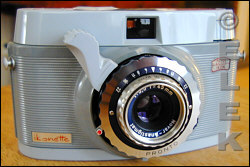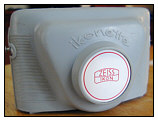Zeiss Ikon Ikonette

|
|
|
| Style, film format | Fixed-lens zone-focus 35mm |
|
|
|
| Lens, shutter | Coated 45mm f/3.5 Novar-Anastigmat, flash-synchronized Pronto with self-timer |
|
|
|
| Photo quality | Very good |
|
|
|
| Ergonomics | Not too bad. Lever on front doubles as film advance and shutter release. |
|
|
|
The Zeiss Ikon Ikonette was introduced in the late 1950s. I've read several things regarding this camera, including one article that said this camera was marketed to women. While I don't know if this is true, most accounts are in agreement in saying that this model suffered from light leaks and was rather hastily recalled and withdrawn from the market.
Some say the camera is rare. I'm not so certain, judging from the number of Ikonettes that show up in online auctions.
 Unlike
most things that I've read, this is not a plastic camera, although it makes
extensive use of plastic. The front shell, top deck and film chamber are
plastic, while the back, bottom plate, inner lens plate and subframe are
die-cast and/or pressed metal. The back also has a traditional metal pressure
plate.
Unlike
most things that I've read, this is not a plastic camera, although it makes
extensive use of plastic. The front shell, top deck and film chamber are
plastic, while the back, bottom plate, inner lens plate and subframe are
die-cast and/or pressed metal. The back also has a traditional metal pressure
plate.
The depth-of-field scale features white numbers on an attractive royal blue. This color scheme is repeated on the lens-face ring. The body itself has a definite curve, which you can see in the photo. The film chamber, however, is flat.
 Zeiss
Ikon selected a very unusual typeface for the camera's nameplate and one
that I've never seen used before. Nor have I seen it used anywhere else.
I'm not sure what the thinking was, but it could support the argument that
the camera was intended for a female buyer. Zeiss Ikon also repeated the
distinctive red-on-silver color scheme with its own logo.
Zeiss
Ikon selected a very unusual typeface for the camera's nameplate and one
that I've never seen used before. Nor have I seen it used anywhere else.
I'm not sure what the thinking was, but it could support the argument that
the camera was intended for a female buyer. Zeiss Ikon also repeated the
distinctive red-on-silver color scheme with its own logo.
The camera has a clean top deck with just a small hole for a cable release and an accessory shoe covered by a lightly sprung plastic plate that completes the flat-top look. There is a small inverted "V" cutout for the frame counter dial, which needs to be manually reset by turning it with your thumb.
 This
particular camera came from Belgium and was not working, which the seller
stated. It came with a blue-and-gray plastic case. I had to break down the
camera, lens and shutter almost entirely to get it working, as well as clean
the very dusty viewfinder. In all, it took me about four hours.
This
particular camera came from Belgium and was not working, which the seller
stated. It came with a blue-and-gray plastic case. I had to break down the
camera, lens and shutter almost entirely to get it working, as well as clean
the very dusty viewfinder. In all, it took me about four hours.
The camera uses a front-mounted single-stroke film-advance lever, which also doubles as the shutter release. Focusing is by guesstimation using the distance scale (marked in meters on my camera), and framing your shot is accomplished with the simple Galilean viewfinder.
To rewind, push to the right a small metal tab that is below the frame counter and then use the thumb and forefinger to repeatedly turn the rewind knob. Very tedious.
A small red cellophane flag intrudes into the viewfinder to let the photographer know the film hasn't been advanced, and the shutter isn't cocked. It's simple, yet effective.
The camera's shape makes it easy to hold, and the front-mounted release is like all front-mounted releases in that it takes some practice. Overall, it's a pleasant little camera.
